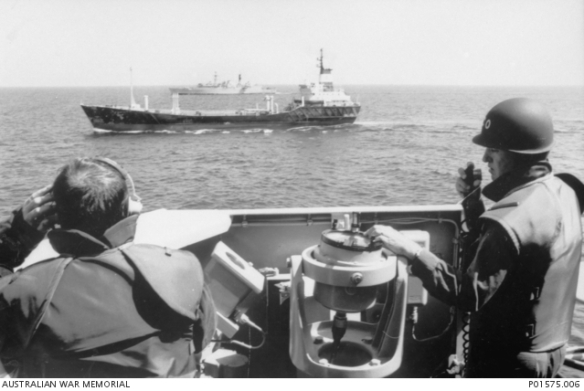
Gulf of Oman: an Iraqi motor vessel is intercepted by HMAS Darwin.
Gulf of Oman, a series of incidents during September-October 1990 in which warships enforced maritime trade sanctions imposed by the United Nations Organisation against Iraq, following that country’s invasion of Kuwait on 2 August. The Australian vessels involved were units of a three-ship RAN task group under Commodore Donald Chalmers, part of a multi-national naval force (MNNF) operating in the Gulf of Oman to control shipping passing through the Strait of Hormuz. Although initially empowered only to identify and warn any vessels encountered, from 10 September the MNNF was authorised to halt, divert or if necessary board and seize any ships attempting to breach the UN blockade.
On 14 September the frigates Darwin and Adelaide were called upon to assist US and British ships in intercepting the 40,000-tonne Iraqi merchantman Al Fao, which had entered the Gulf of Oman and was heading towards the strait. Several calls to stop and warning machine-gun fire from a US frigate had gone unheeded by the ship, whose master claimed he needed approval from Baghdad. While Adelaide and HMS York positioned themselves to prevent the Al Fao from entering Iranian territorial waters, the action of Darwin in firing further warning shots from a .50-calibre machinegun across the Iraqi’s bows finally brought the vessel to a halt at 4.50 p. m. It was another three hours, however, before the captain lowered a ladder and permitted an American-Australian search party on board to carry out an inspection. Once it was confirmed that Al Fao was in ballast, the vessel was permitted to proceed into the Arabian (or Persian) Gulf.
On 8 October Darwin and Adelaide were separately involved in two similar incidents south of Ra’s al Hadd, near Masirah Island off Oman. When the 6,000-tonne Iraqi cargo ship Al Wasitti also refused to comply with orders to stop, warning shots were fired across her bow-initially from a machine-gun, but then from Adelaide’s 76-mm gun. This was thus the first time an RAN vessel had fired its main gun armament in anger since the Vietnam conflict. Marines from a British ship were then landed by rope from helicopters to seize control of the bridge of both Iraqi vessels, after which boarding teams from other warships were sent by boat.
While the Al Wasitti was established to be empty and allowed to proceed, the other vessel-the 3,500-tonne tanker Tadmur- was found to be carrying prohibited cargo. With a combined British-American- Australian party embarked until the next day, the ship was diverted to Muscat. Darwin had resumed patrol duty when word was received that the Tadmur had been mistakenly released at Muscat, still carrying her illegal cargo. Adelaide was among the vessels assigned to again apprehend her, and only after six tonnes of goods had been taken off with the assistance of Adelaide’s Seahawk helicopter was the Tadmur permitted to proceed on its way to Iraq.
Yet another notably difficult interception involved the 155,000-tonne supertanker Amuriyah on 28 October. The master of this vessel brazenly invited the most drastic measures to be applied against him by ignoring all warnings-including radio calls, sirens sounded at close quarters, a written message displayed from a helicopter sent by Darwin to hover near the ship’s bridge, aggressive manoeuvring, and buzzing by two fighters from the US aircraft-carrier Independence. Warning shots were tried next, with Darwin firing 200 .50-calibre rounds (initially at 300 metres but later just 100 metres in front of the tanker’s bows) and a US warship sending a similar warning with 5-inch rounds. When 30 US marines were eventually landed by helicopter on the tanker’s foredeck at about 9.20 a. m., the Iraqi captain ordered water-cannon used against them. Other measures taken to frustrate the boarders included switching off onboard lights and locking compartments; one Iraqi attacked a marine with an axe until forcibly restrained. The search of the Amuriyah was accomplished with its master and engineer both in handcuffs. Only once it was certain that the vessel had no cargo was it permitted to proceed at about 3 p. m.
During the first three months of the MNNF’s operations, nineteen merchant ships deemed to be breaching the UN embargo were diverted to ports. Eleven of these had initially refused to stop when challenged, and in ten cases warning shots had to be fired to enforce compliance. RAN ships were involved in five of the latter instances.
Tom Frame (1992) Pacific Partners: A History of Australian-American Naval Relations, Sydney: Hodder & Stoughton; David Horner (1992) The Gulf Commitment: The Australian Defence Force’s First War, Carlton, Vic.: Melbourne University Press